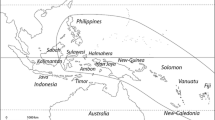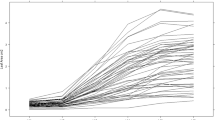Summary
One 3-to 5-year clonal and two recent seedling-derived populations of white yam cultivars were grown and studied for the association of sex, flowering intensity, number of fruits and seed yield with vegetative characters and tuber yield. Yield was lowest in non-flowering plants and increased in the following order: male, monoecious and female plants; with females yielding almost twice as much as the non-flowering plants. The plants produced from small tuber setts, with higher leaf virus infection, low plant leafiness either had low flowering intensity, fewer fruits and seeds or even failed to flower. The sequence and timing of vegetative and reproductive processes in relation to the difference in yield between male and female plants is discussed. There is a strong indication that the intensity of flowering and fruiting is lower in plants from previous vegetative propagation compared to recent seedling-serived clones.
Similar content being viewed by others
References
Anonymous, 1974. 1974 Annual Report of IITA, Ibadan, Nigeria. pp. 148.
Anonymous, 1976. 1976 Annual Report of IITA, Ibadan, Nigeria. pp. 64.
Campbell J. S., V. O. Chukwueke, F. A. Teriba & H. V. S. Hoa-a-Shu, 1962. Some physiological investigations into the white lisbon yam (Dioscorea alata). II. Growth period and out-of-season production. Emp. J. Expl. Agric. 30: 232–38.
Degras, L., 1976. Vegetative and sexual management in food yam improvement. Proc. 4th Symp. Int. Soc. Trop. Root Crops. Cali, Colombia pp. 58–62.
Degras, L., 1978. Les problems d'amelioration genetique de l'igname vus a travers celle de Dioscorea trifida L. Proc. 1st Int. Sem. Yams pp. 19–34.
Enyi, B. A. C., 1973. Growth, development and yield of some tropical root crops. Proc. 3rd Symp. Int. Soc. Trop. Root Crops. pp. 87–103.
Epenhuijsen C. W.van 1974. Growing native vegetables in Nigeria. Rome: FAO. 113 pp.
Ferguson, T. U., 1973. Tuber development in yams: physiological and agronomic implications. Proc. 3rd Symp. Int. Soc. Trop. Root Crops. pp. 72–77.
Henry, V. C. R., 1967. Studies on botanical and agronomic characteristics in cush-cush (Dioscorea trifida L. F.) Ph.D. Thesis, McGill University, Montreal, Canada, 190 pp.
Hinson J. R. E., 1935. Sexes of yam plants; Observations at Asuansi. Gold Coast Farmer 3: 186.
Martin F. W., 1966. Sex ratio and sex determination in Dioscorea. J. Hered. 57: 95–99.
Martin F. W., 1972. Yam production methods. Production Res. Rept. No. 147. Washington, D. C., ARS-USDA. 177 p.
Phillips T. A., 1973. An agricultural notebook. Ibadan: Longman. 248 pp.
Posthumus, A. C., 1973. Environmental factors affecting tuberization. Proc. 3rd Symp. Int. Soc. Trop. Root Crops. Ibadan, Nigeria pp. 65–71.
Sobulo R. A., 1972. Studies on white yam (Dioscorea rotundata). I. Growth analysis. Expl. Agric. 8: 99–106.
Terry, E. R., 1976. Incidence, Symptomatology and transmission of a yam virus in Nigeria. Proc. 4th Symp. Int. Soc. Trop. Root Crops. Cali, Colombia, pp. 170–73.
Tindall H. D., 1965. Fruitc and vegetables in West Africa. Rome: FAO. 259 pp.
Waitt A. W., 1963. Yams, Dioscorea species. Field Crops Abstr. 16: 145–57.
Author information
Authors and Affiliations
Rights and permissions
About this article
Cite this article
Akoroda, M.O., Wilson, J. & Chheda, H.R. The association of sexuality with plant traits and tuber yield in white yam. Euphytica 33, 435–442 (1984). https://doi.org/10.1007/BF00021142
Received:
Issue Date:
DOI: https://doi.org/10.1007/BF00021142




